
The Scoliidae, the scoliid wasps, are a family of about 560 species found worldwide. They tend to be black, often marked with yellow or orange, and their wing tips are distinctively corrugated. Males are more slender and elongated than females, with significantly longer antennae, but the sexual dimorphism is not as apparent as in the Tiphiidae.
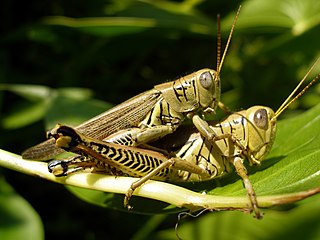
The differential grasshopper is a species of grasshopper belonging to the genus Melanoplus. It is found throughout northern Mexico, the central United States and southern Ontario, Canada. It is considered a pest over most of its range.

Sphecomyrma is an extinct genus of ants which existed in the Cretaceous approximately 79 to 92 million years ago. The first specimens were collected in 1966, found embedded in amber which had been exposed in the cliffs of Cliffwood, New Jersey, by Edmund Frey and his wife. In 1967, zoologists E. O. Wilson, Frank Carpenter and William L. Brown, Jr. published a paper describing and naming Sphecomyrma freyi. They described an ant with a mosaic of features—a mix of characteristics from modern ants and aculeate wasps. It possessed a metapleural gland, a feature unique to ants. Furthermore, it was wingless and had a petiole which was ant-like in form. The mandibles were short and wasp-like with only two teeth, the gaster was constricted, and the middle and hind legs had double tibial spurs. The antennae were, in form, midway between the wasps and ants, having a short first segment but a long flexible funiculus. Two additional species, S. canadensis and S. mesaki, were described in 1985 and 2005, respectively.

Burnsius communis, the common checkered-skipper, formerly known as Pyrgus communis, is a species of butterfly in the family Hesperiidae. It is known as the frequently seen Pyrginae species in the northern United States by collectors and watchers alike.
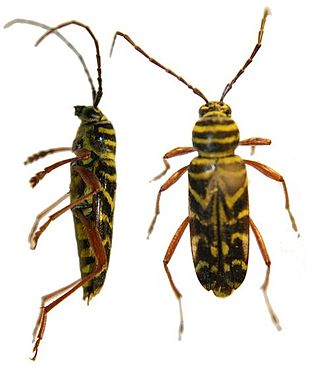
Megacyllene robiniae, commonly known as the locust borer, is a species of longhorn beetle endemic to eastern North America. It is a serious pest of Robinia pseudoacacia, the black locust tree, with which it is sympatric.

The eastern yellow jacket or eastern yellowjacket is a wasp found in eastern North America. Although most of their nests are subterranean, they are often considered a pest due to their nesting in recreational areas and buildings. This yellow jacket is a social insect, living in colonies of hundreds to thousands of individuals. Along with their subfamily, Vespinae, this species demonstrates supportive parental care for offspring, separation of reproductive and sterile castes, and overlapping generations. They aggressively defend their hives from threats and are known to inflict painful stings.

Megascolia procer, the giant scoliid wasp, is a solitary wasp in the family Scoliidae found across the Oriental region. It is one of the largest wasps in the world, with a wingspan of 11.6 cm (4.6 in).

The cottonwood borer is a species of longhorn beetle found in the United States east of the Rocky Mountains that feeds on cottonwood trees. It is one of the largest insects in North America, with lengths reaching 40 millimetres (1.6 in) and widths, 12 mm (0.47 in). It is the only species in the genus Plectrodera.

Scolia dubia, also known as the two-spotted scoliid wasp or a blue-winged scoliid wasp, is a species in the family Scoliidae.

Polistes carnifex, commonly known as the executioner wasp, is a neotropical vespid wasp in the cosmopolitan genus Polistes.

Polistes apachus is a social wasp native to western North America. It is known in English by the common name Texas paper wasp, or southwestern Texas paper wasp. It has also been called the Apache wasp, perhaps first by Simmons et al. in California in 1948. Simmons et al. reported how in California P. apachus is often found in fig orchards where it is considered a pest species due to its aggressive attacks and painful stings on farm labourers during harvest time in September and October. It may sometimes also be found in other types of orchards or in vineyards, but in California it is also commonly found to establish nests in or on houses in urban areas in attics or under the eaves of buildings. It is a type of paper wasp, which is the common name for a type of wasp that uses a papery material to construct its nests.
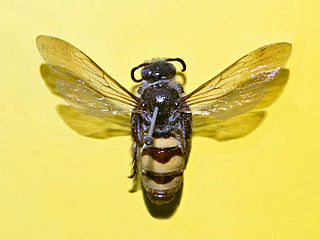
Dielis trifasciata, also known as the three-banded scoliid wasp, is a species in the family Scoliidae.

Poecilopompilus interruptus is a species of New World spider wasps.

Capnobotes fuliginosus is a species of katydid known as the sooty longwing. It is found in the western United States and Mexico. It is omnivorous and it is the prey of the wasp Palmodes praestans.

Sphex nudus, the katydid wasp, is a species of thread-waisted wasp in the family Sphecidae.
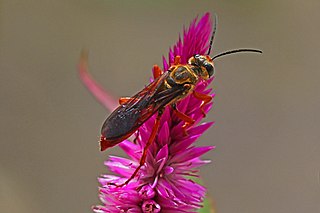
Sphex jamaicensis is a species of thread-waisted wasp in the family Sphecidae. It is found in Florida, Cuba, The Bahamas, and Jamaica.
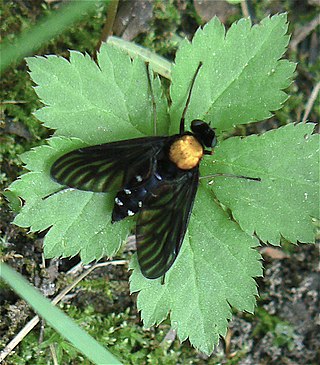
Chrysopilus thoracicus, the golden-backed snipe fly, is a species of snipe fly in the family Rhagionidae.

Auplopus architectus is a species of spider wasp of the family Pompilidae.
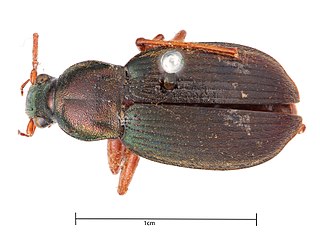
Chlaenius aestivus is a species of beetle of the family Carabidae.

Dielis tolteca, the Toltec scoliid wasp, is a species of hymenopteran in the family Scoliidae. It is commonly found on plants in the genus Solidago.




















